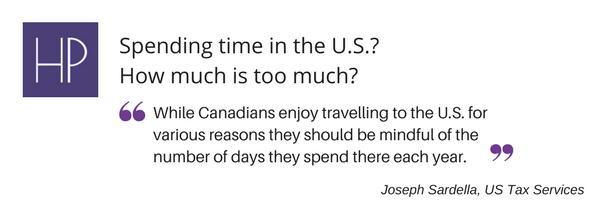While Canadians enjoy travelling to the U.S. for various reasons they should be mindful of the number of days they spend there each year. The U.S. has a substantial presence test; a formula to determine whether you have been physically present in the U.S. for over a certain number of days over a 3-year period. If your day count is over this threshold, the U.S. will consider you to be a resident for tax purposes thereby subjecting you to tax filings.
To determine your day count, you must be physically present in the U.S. on at least:
31 days during the current year and
183 days during the 3-year period that includes the current year and the 2 years immediately before the current year, by adding:
- 100% of the days you were present in the current year, and
- 1/3 of the days you were present in the first year before the current year, and
- 1/6 of the days you were present in the second year before the current year.
For example, if you were physically present in the U.S. for 120 days in each of the years 2017, 2016 and 2015, the substantial presence test is met by counting all of the days in 2017, 1/6 of the days in 2016 and 1/3 of the days in 2015. This total of 180 days is under the 183-day threshold; the substantial presence test is not met and you will not be considered a U.S. resident for tax purposes. Generally, by spending no more than 120 days in the U.S., in a taxation year, you should not be caught by the substantial presence test.
Physical Presence
While you may have set foot in the U.S. there are some exceptions to meeting the substantial presence test whereby certain days will not count toward the test. Some exceptions include:
- Days you are an “exempt individual”
- A student in the U.S. while on a visa or
- An individual unable to leave because of a medical condition that arose while in the U.S.
- Days you commute to work in the U.S. from a residence in Canada or if you regularly commute from Canada to and from the U.S. each day
- Days you are in the U.S. as a crew member of a foreign vessel
- Days you are in the U.S. for less than 24 hours, when you are in transit between two places outside the United States.
Exceeding the Substantial Presence Test
You have exceeded the substantial presence test. Now what? You can still be treated as a nonresident alien of the U.S. by taking the position that you have a closer connection to Canada by filing Form 8840 with the IRS. The form establishes that your tax home, financial, economic and personal interests lie within Canada where you have a closer connection. The form is due June 30 of the year following the 3-year period.
Note that you can avoid filing Form 8840 by ensuring you spend less than approximately 120 days in the U.S. in each 3-year period.
If you spend 183 days or more in the U.S. in one year then the Closer Connection Exception form cannot be used and a U.S. tax return would have to be filed whereby worldwide income is reported although U.S. source income will be taxed.
